Football stadiums are not just places where games are played but iconic landmarks representing football fans’ passion, pride, and spirit worldwide.
A stadium’s size, capacity, and grandeur can profoundly impact how we experience the game. From the crowd’s roar to the breathtaking views, every aspect of a stadium can make us feel like we are part of something special.
Discover the biggest football stadiums in the world that have left an indelible mark on the sport and its fans.
So grab your virtual ticket, get ready to experience the thrill of the game, and let’s dive into the world of the biggest football stadiums.
Top 10 Largest Football Stadiums in the World
Here’s our top pick for the largest soccer stadiums in the world based on seating capacity.
1. Rungrado 1st of May Stadium
- Location: Pyongyang, North Korea
- Opened: 1989
- Seating Capacity: 114,000
- Construction Cost: Unknown
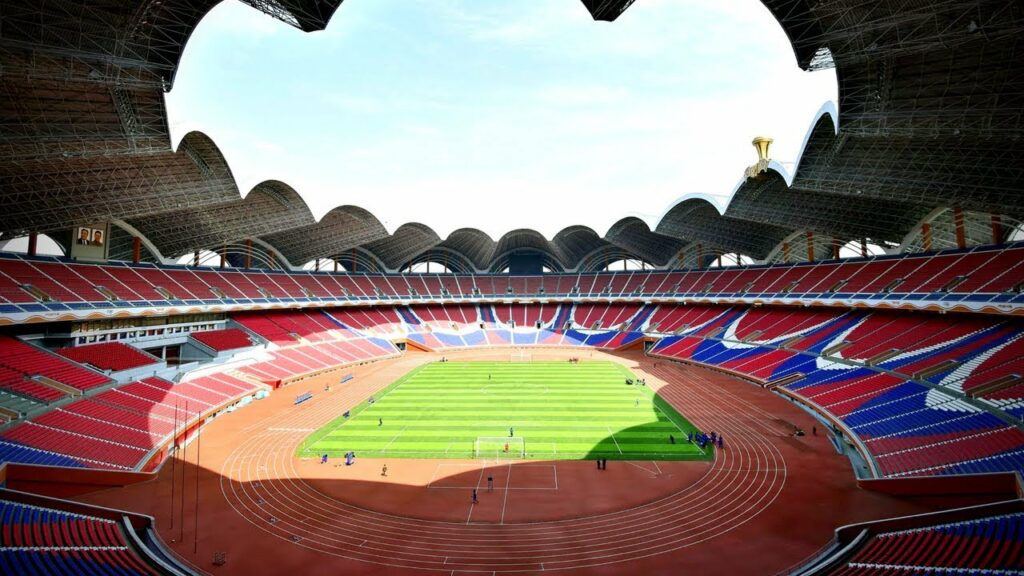
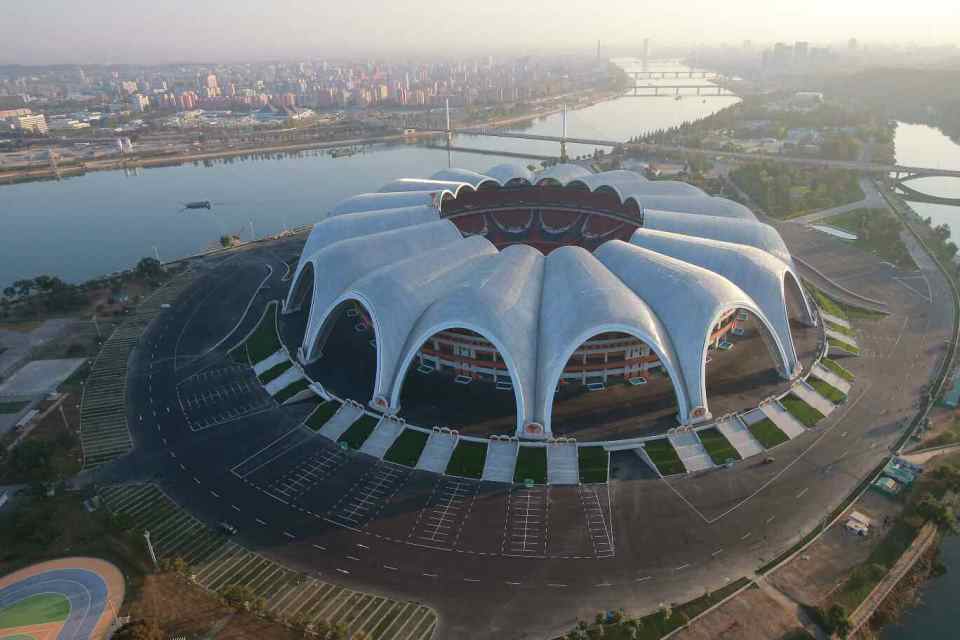
The Rungrado 1st of May Stadium in Pyongyang, North Korea, is widely considered one of the world’s largest football stadiums and the world’s highest-capacity stadium. This impressive stadium has a seating capacity 150,000, making it the largest stadium by capacity in the world.
The stadium was built in 1989 and is primarily used for football matches, other sporting events and cultural performances. The stadium’s design is unique, with a large circular shape and a towering roof covering the entire seating area. 16 massive arches support the roof, and the stadium is surrounded by a moat that adds to its grandeur.
The stadium’s name, Rungrado, on the 1st of May, refers to International Workers’ Day, celebrated on May 1st. The stadium was built to commemorate the 70th birthday of North Korea’s founder, Kim Il-Sung.
2. Michigan Stadium
- Location: Ann Arbor, Michigan, USA
- Opened: 1927
- Seating Capacity: 107,601
- Construction Cost: $950,000
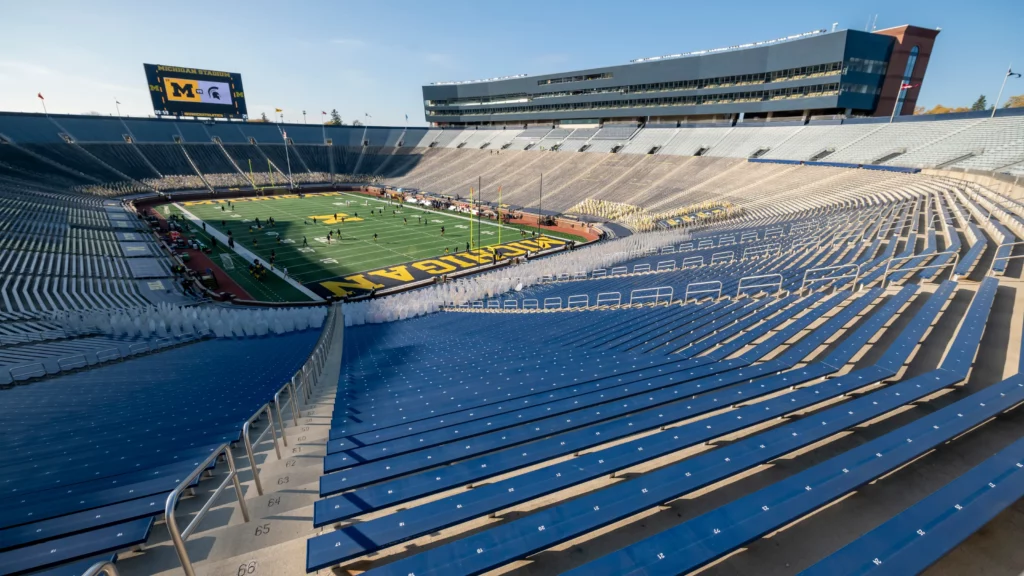
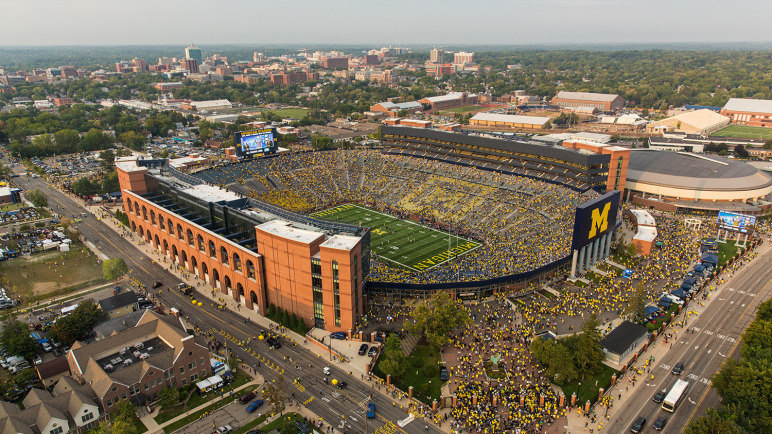
Michigan Stadium, or “The Big House,” is one of the biggest soccer stadiums in the world, present in Ann Arbor, Michigan, USA. It is the home of the University of Michigan’s Wolverines football team. It has a seating capacity of 107,601, making it the largest stadium in the United States and the second-largest stadium in the world.
The stadium was initially built in 1927, with a capacity of just over 72,000. It was designed by the architect Bernard Green, who incorporated elements of classical architecture into the stadium’s design. Over the years, the stadium has undergone several renovations and expansions, with the most recent renovation in 2010.
The stadium has also hosted many other important events, including political rallies, concerts, and soccer matches. In 2014, the stadium hosted the International Champions Cup match between Manchester United and Real Madrid, which drew a crowd of over 109,000 spectators.
3. Ohio Stadium
- Location: Columbus, Ohio, USA
- Opened: 1922
- Seating Capacity: 102,780
- Construction Cost: $1.3 million
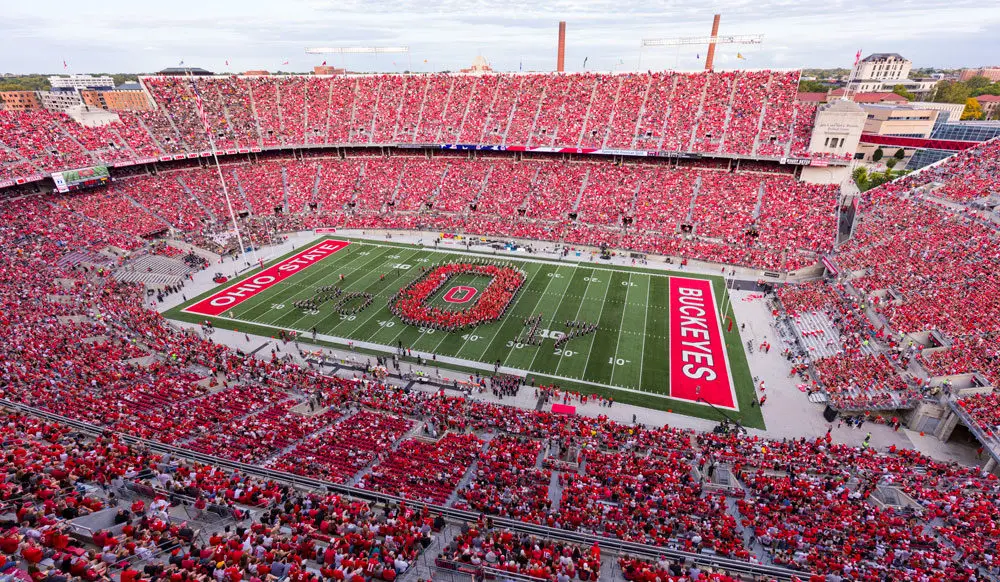

Ohio Stadium, also known as “The Horseshoe,” is a historic football stadium located on the campus of The Ohio State University in Columbus, Ohio, USA. It is the home of the Ohio State Buckeyes football team and has a seating capacity of 102,780, making it one of the largest stadiums in the United States.
The stadium opened in 1922 and has undergone several renovations and expansions. The stadium’s original capacity was just over 66,000, but it has since been expanded to its current size.
Ohio Stadium has a rich history, hosting many essential football games and events. One of the most famous games played at the stadium was the 2002 National Championship game, in which Ohio State defeated the University of Miami. The stadium has also hosted multiple Ohio State-Michigan rivalry games, some of college football’s most intense and anticipated games.
The construction cost of Ohio Stadium was around $1.3 million when it was first built in 1922. However, over the years, the stadium has undergone many renovations and expansions, which have added to the total cost of the facility.
4. Camp Nou
- Location: Barcelona, Catalonia, Spain
- Opened: 1957
- Seating Capacity: 99,354
- Construction Cost: €900 million

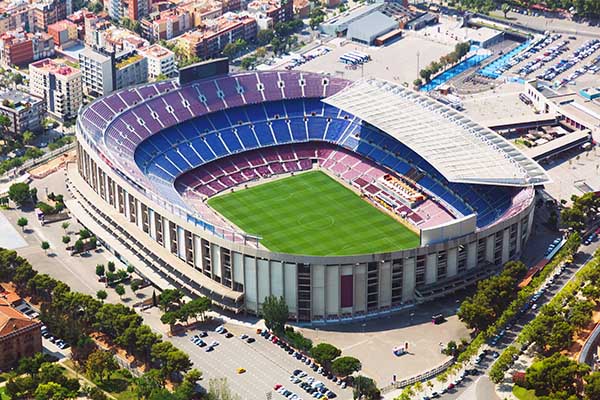
Camp Nou Stadium, also known as Nou Camp, is one of the largest stadiums in the world, situated in Barcelona, Spain. It is the home of FC Barcelona and has a seating capacity of 99,354, making it the largest stadium in Spain and one of the largest in the world.
The stadium opened in 1957 and has undergone several renovations and expansions. The stadium’s original capacity was just over 93,000, but it has since been expanded to its current size. The most recent renovation occurred between 2017 and 2020, including adding a new roof and improved facilities.
The construction cost of Camp Nou Stadium was around 288 million pesetas when it was first built in 1957. One of the most famous games played at the stadium was the 1999 Champions League Final, in which Manchester United defeated Bayern Munich.
Despite its large size, the stadium’s unique design, with its steep stands and open corners, creates a sense of intimacy. The stadium is also famous for its unique atmosphere, with passionate fans known as “Culés” filling the stands and creating a lively and energetic atmosphere.
5. FNB Stadium
- Location: Johannesburg, South Africa
- Opened: 1989
- Seating Capacity: 94,736
- Construction Cost: $440 million


FNB Stadium, or Soccer City, is a football stadium in Johannesburg, South Africa. It is the largest stadium in Africa and has a seating capacity 94,736.
The stadium opened in 1989 and was originally known as the National Stadium. It underwent a major renovation between 2006 and 2009 in preparation for the 2010 FIFA World Cup, which was held in South Africa. The renovation included the addition of a new roof and improved facilities, as well as the installation of new seats.
The stadium’s unique design, distinctive calabash shape and patterned exterior have become an iconic symbol of South African football. The design was inspired by traditional African pottery and was intended to reflect the culture and heritage of South Africa.
The construction cost of FNB Stadium was around 440 million South African Rand when it was first built in 1989. However, the cost of the stadium’s renovation in 2009 was much higher, with estimates ranging from 2 to 3 billion Rand.
6. Rose Bowl
- Location: Pasadena, United States
- Opened: 1922
- Seating Capacity: 95,542
- Construction Cost: $4 million in 2019
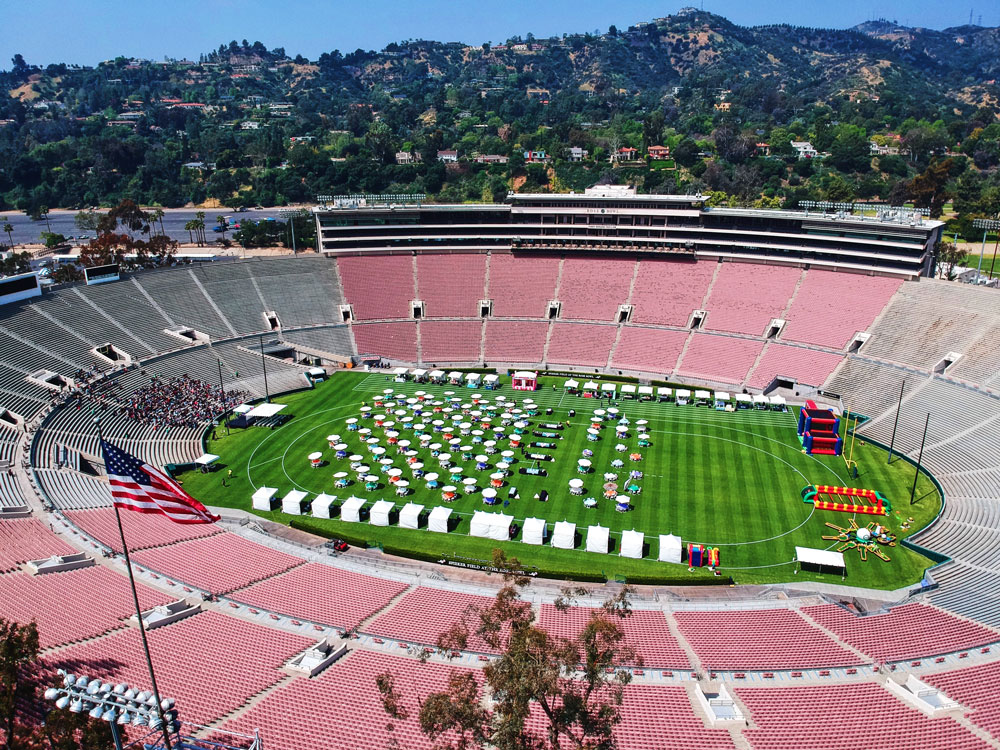
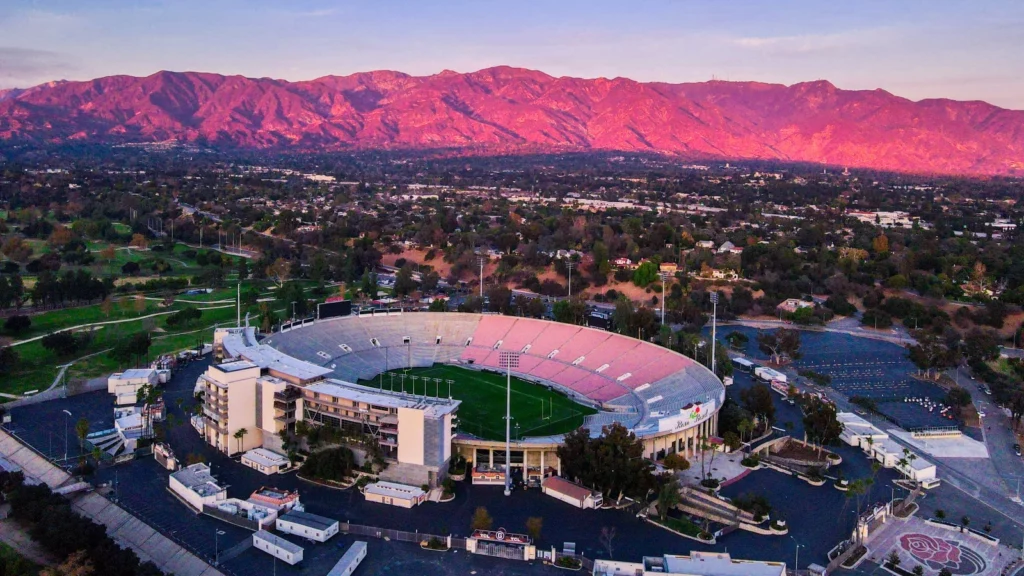
Rose Bowl Stadium is a historic football stadium in Pasadena, California, USA. It is one of the world’s most iconic and well-known stadiums, with a seating capacity 90,888.
The stadium opened in 1922 and has become a staple of American football culture. It is the home of the annual Rose Bowl Game, one of the most bowl games in college football, which has been played at the stadium every year since 1923, except in 1942 due to World War II.
Over the years, the Rose Bowl Stadium has hosted many important football games, including five Super Bowl games and the 1994 FIFA World Cup Final. The stadium has also been used for other events, such as concerts, religious services, and even the 1984 Olympic Games, where it served as the venue for the track and field events.
7. Sanford Stadium
- Location: Athens, Georgia, United States
- Opened: 1922
- Seating Capacity: 92,746
- Construction Cost: Unknown
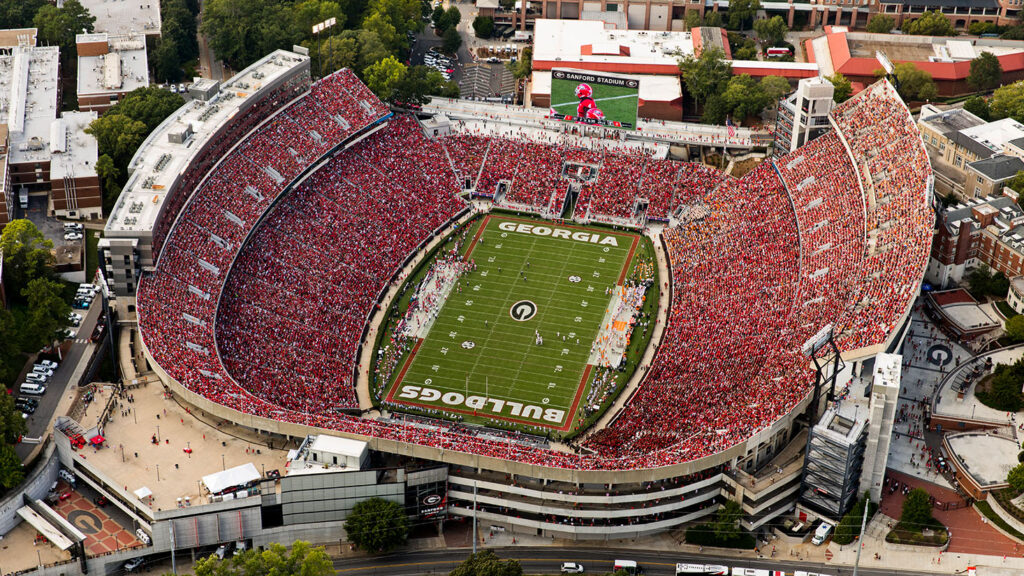
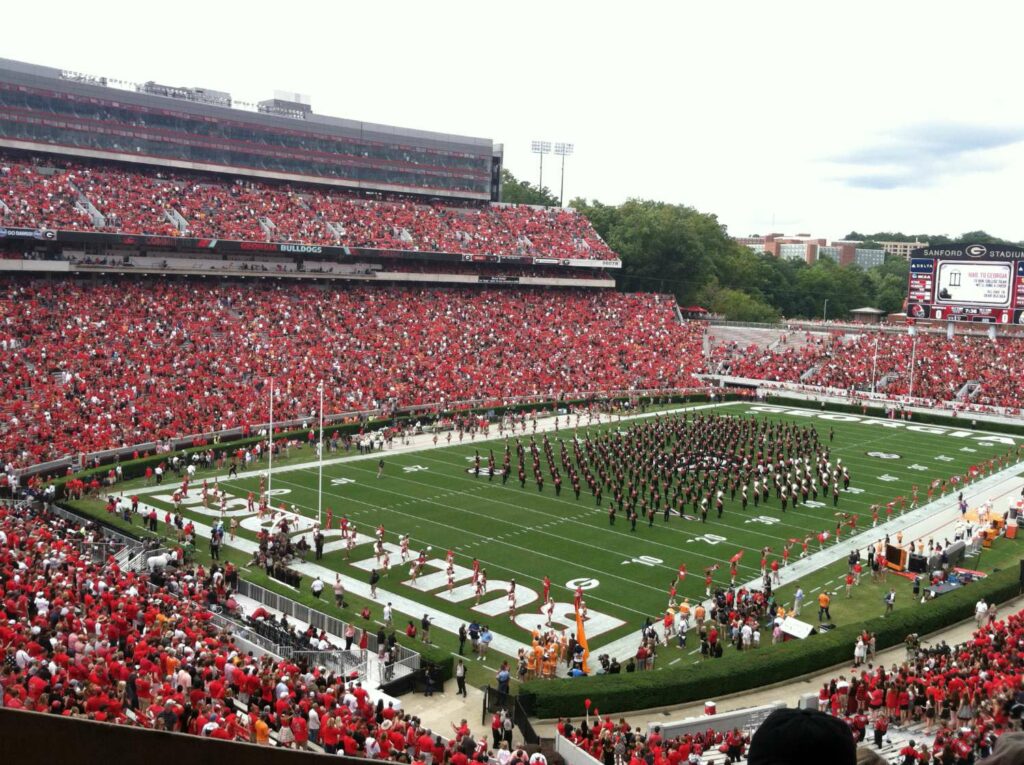
Sanford Stadium is a historic football stadium located on the campus of the University of Georgia in Athens, Georgia, USA. It is the home of the Georgia Bulldogs football team and has a seating capacity of 92,746.
The stadium opened in 1929 and has undergone several renovations, including major expansions in 1967, 1981, and 1994. The most recent renovation in 2018 added new amenities, including a state-of-the-art video board and sound system, upgraded seating, and improved concessions and restrooms.
Sanford Stadium has become a beloved icon in college football, known for its classic architecture and lively game-day atmosphere. The stadium’s design features a traditional bowl shape, with a steeply sloping bowl that provides excellent field views from every seat.
One of the most distinctive features of Sanford Stadium is its famous hedges, which line the field and have become a cherished symbol of Georgia football. The hedges were planted in 1929 and have been carefully maintained over the years, serving as a unique and memorable stadium feature.
8. Cotton Bowl Stadium
- Location: Dallas, Texas, USA
- Opened: 1998
- Seating Capacity: 92,100
- Construction Cost: Unknown
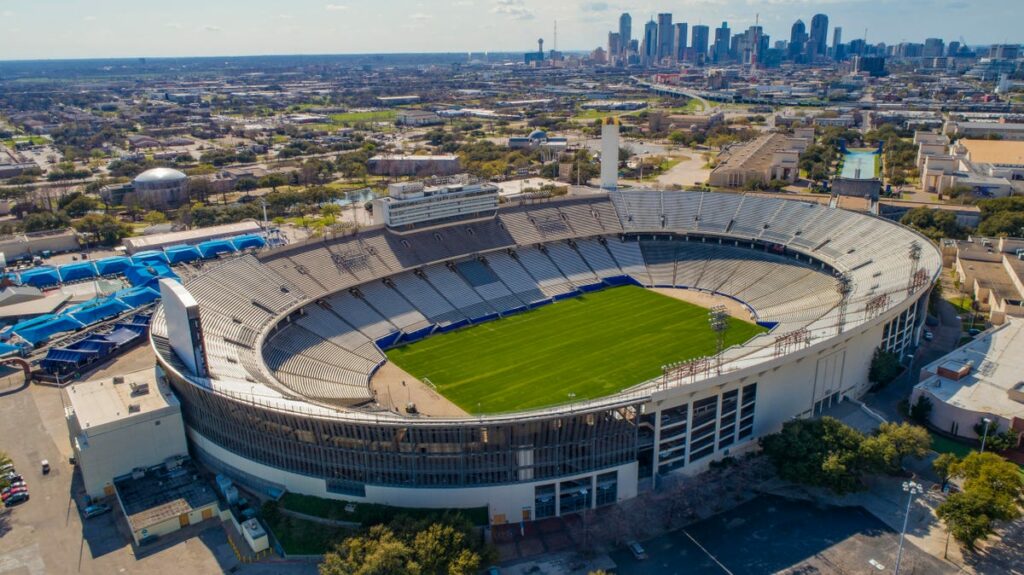
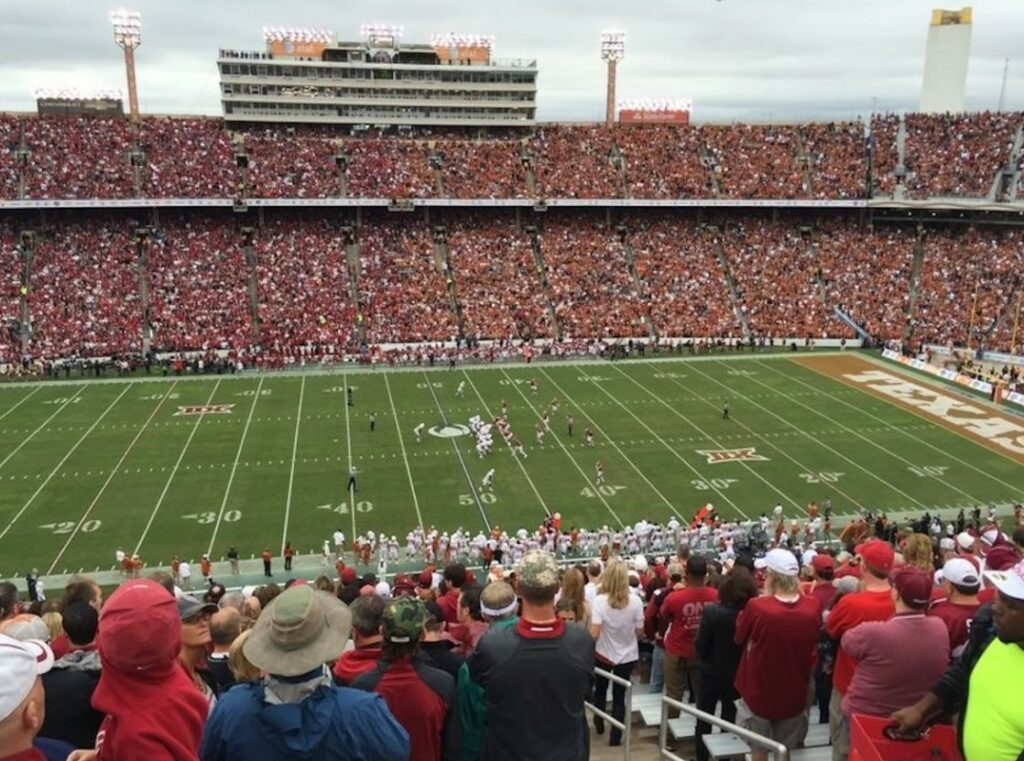
Cotton Bowl Stadium is a historic Dallas, Texas, United States sports arena. The stadium, which opened in 1930, has a seating capacity of over 92,100, making it one of the largest stadiums in Texas. It has hosted various events, including college football games, concerts, and other sporting events.
The stadium is perhaps best known for hosting the Cotton Bowl Classic, an annual college football bowl game held at the stadium since 1937. The game features top teams from around the country and has been the site of many historical matchups. In addition to the Cotton Bowl Classic, the stadium has hosted several other college football games, including the Red River Showdown between the University of Texas and the University of Oklahoma.
In addition to football, Cotton Bowl Stadium has also hosted several other sporting events over the years, including soccer matches, boxing matches, and track and field events. The stadium was also the 1966 NFL Championship Game site, where the Dallas Cowboys defeated the Green Bay Packers.
Over the years, Cotton Bowl Stadium has undergone several renovations and upgrades to modernize the facility and improve the fan experience. In 2008, the stadium underwent a major renovation project that included the installation of new seating, upgraded concession stands, and improved restroom facilities.
9. Wembley Stadium
- Location: London, England
- Opened: 2007
- Seating Capacity: 90,000
- Construction Cost: £789 million in 2007
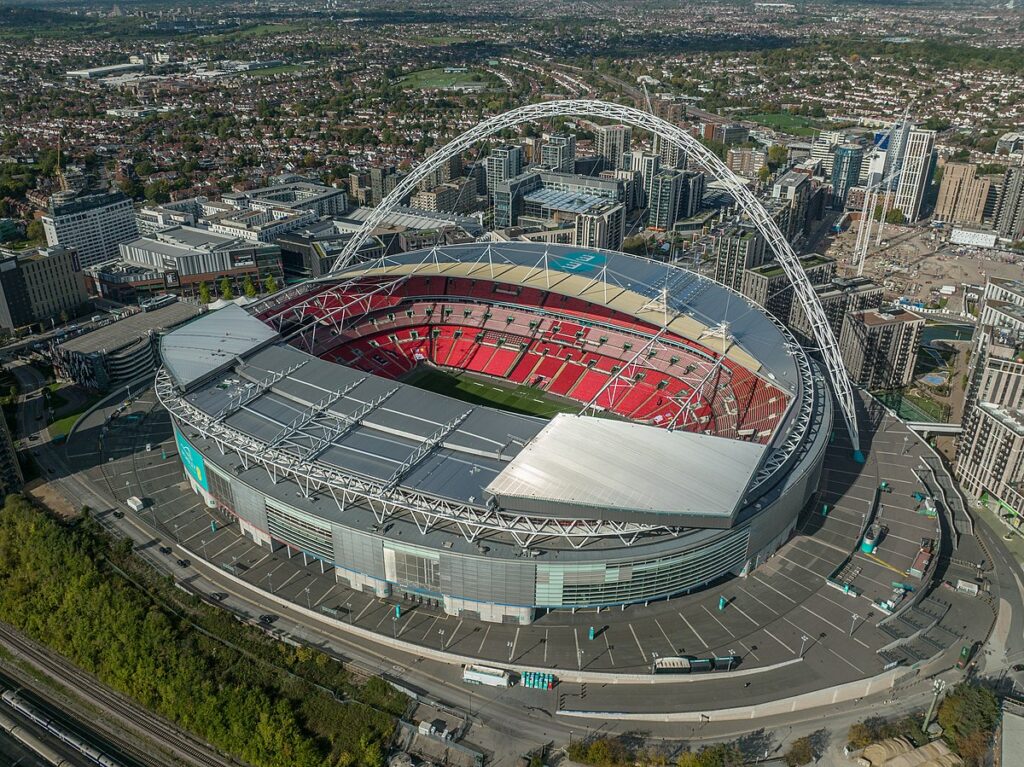
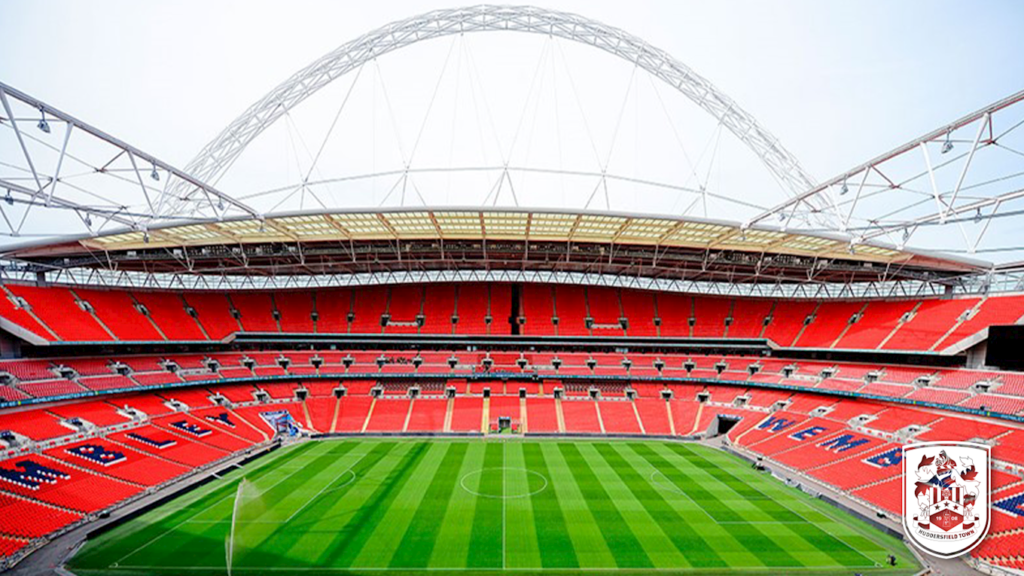
Wembley Stadium is a historic sports arena located in London, England. The stadium opened in 2007 and has a seating capacity of over 90,000, making it the largest stadium in the United Kingdom and the second-largest stadium in Europe.
The stadium has a rich history, as it was built on the site of the old Wembley Stadium, which was known for hosting major events such as the 1948 Summer Olympics, the 1966 FIFA World Cup final, and Live Aid in 1985. The old stadium was demolished in 2003, and the new stadium was built at the cost of over £1 billion.
Wembley Stadium is primarily used for football (soccer) matches and is the home of the England national football team. It also hosts the finals of major domestic cup competitions, such as the FA Cup and the EFL Cup, as well as the Football League play-off finals.
In addition to football, Wembley Stadium has hosted various other events over the years, including rugby matches, NFL games, boxing matches, and music concerts. Some of the biggest names in music have performed at the stadium, including Beyoncé, Ed Sheeran, and Adele.
10. Estadio Azteca
- Location: Mexico City, Mexico
- Opened: 1966
- Seating Capacity: 87,525
- Construction Cost: MXN$260 million

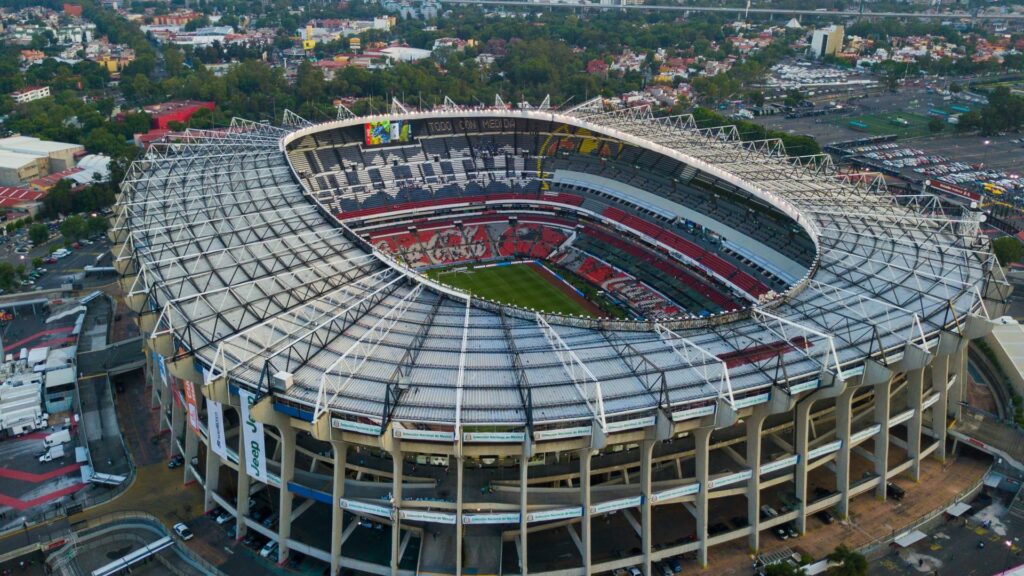
Estadio Azteca is also one of the biggest stadiums in Mexico City, Mexico. It was inaugurated in 1966 and had a capacity of 87,523 spectators, making it one of the largest stadiums in the world.
The stadium has hosted several important football events, including the 1970 and 1986 FIFA World Cups. It was also the first stadium to host two World Cup finals, and it has been the venue for several CONCACAF Champions League finals and other important matches.
In addition to football, Estadio Azteca has also hosted concerts and other events, including performances by iconic artists such as Michael Jackson, U2, and Madonna.
The stadium’s unique design features a circular shape with a massive concrete roof covering all the seats. The roof is supported by a ring of concrete columns set back from the stadium’s edge, allowing unobstructed views from all seats.
Also Read: Worst NFL Stadiums by Ranking
Few Facts About Largest Stadiums
- Staggering construction costs
When adjusting for inflation, the construction costs for the top 10 biggest stadiums in the world would exceed £5 billion! Building these colossal structures required an immense amount of time and effort.
- Capacities used to be larger
Safety measures were less strict in the past, allowing stadiums to host many more spectators than today. Some of these stadiums used to have capacities greater than 100,000 before safety regulations were introduced.
- Wembley has the most toilets.
Wembley Stadium in London boasts the most toilets of any building worldwide, making it the perfect venue to avoid the halftime bathroom rush.
- The uncertain capacity of Rungrado 1st of May Stadium
The Rungrado 1st of May Stadium in North Korea has a listed capacity of 114,000; the actual seating arrangements and capacity are unknown due to the country’s secretive nature. It’s possible that the stadium can hold more than 150,000 people.
Also Read: Largest NFL Stadiums
Frequently Asked Questions
Which stadium is known as the “Home of Football”?
Wembley Stadium in London, England, is often called the “Home of Football.” It is an iconic venue and has hosted numerous important football matches, including the finals of major tournaments.
What is the most famous football stadium in the world?
Maracanã Stadium in Rio de Janeiro, Brazil, is widely regarded as one of the most famous football stadiums in the world. It has a rich history and has hosted several significant matches, including the FIFA World Cup finals.
Which stadium is considered the best for atmosphere?
Signal Iduna Park, also known as Westfalenstadion, in Dortmund, Germany, is renowned for its incredible atmosphere. The passionate and vibrant fans of Borussia Dortmund create an electric atmosphere during matches.
What is the most technologically advanced stadium?
Mercedes-Benz Stadium in Atlanta, Georgia, USA, is considered one of the most technologically advanced stadiums in the world. It features cutting-edge technology, including a retractable roof, LED video screens, and an advanced Wi-Fi network.
Which stadium has the best pitch quality?
The Emirates Stadium in London, England, is known for having one of the best pitch qualities in the world. The stadium’s pitch is meticulously maintained to provide an excellent playing surface for football matches.
What is the oldest stadium in the world?
The Hampden Park Stadium in Glasgow, Scotland, is recognized as the oldest international football stadium. It was opened in 1903 and has a rich history of hosting major football events.
Which stadium has the most unique architecture?
The Allianz Arena in Munich, Germany, is renowned for its unique architecture. The stadium features a futuristic design with a transparent outer shell that can be illuminated in different colors.
Which stadium offers the best panoramic views?
The Camp Nou stadium in Barcelona, Spain, offers breathtaking panoramic views of the playing field from various sections. It is the largest stadium in Europe and provides an incredible viewing experience.
Which stadium is known for its acoustics?
La Bombonera stadium in Buenos Aires, Argentina, is famous for its exceptional acoustics. The steep stands and compact design create an intense and reverberating atmosphere during matches.
